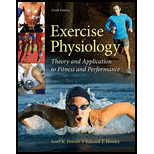
Concept explainers
To discuss: The relationship between exercise intensity and bioenergetic pathways that produces ATP during various types of exercise.
Introduction: Exercise includes all the bodily activities that help to enhance or maintain physical fitness for overall health and wellness. Exercise can be performed for various reasons such as to aid growth, improve strength, prevent aging, develop muscles, weight loss, and also for enjoyment.
Explanation of Solution
Adenosine triphosphate (ATP) is the primary source of energy in most of the cells. The three major sources of energy systems that are involved in ATP production during exercise are ATP-PC system, aerobic, and anaerobic pathways. The sources of ATP during different types of exercise are summarized as follows:
- The energy source for high intensity short-term exercise is from anaerobic metabolic pathways.
- The adenosine triphosphate-phosphocreatine (ATP-PC) system provides energy for various movements or exercises like quick reactions, sprints, and other exercises that last for about 1‑5 seconds.
- Glycolysis supplies most of ATP for intense exercise like long distance sprints; however, all three energy systems are involved in energy production.
- Intense exercise that lasts about a minute uses all the energy systems; however the ratio of anaerobic to aerobic pathway is 70% to 30%.
- For prolonged exercises and beginning of incremental exercising, the aerobic
metabolism supplies most of the energy.
Want to see more full solutions like this?
Chapter 4 Solutions
Exercise Physiology: Theory and Application to Fitness and Performance
- A. Describe the steps in a PCR reaction in detail B. Describe what it means that DNA replication is semiconservative. C. Discuss chromatin remodeling D. Draw a prokaryotic replication fork and include all of the major proteins associated with prokaryotic DNA replication and also label leading and lagging strands, Okazaki fragments, 3' and 5' ends of both sides of the fork, primers, and anything else relevant to replication.arrow_forwardWhat is a transposon, and what are two different types of transposons?arrow_forwardTranscription in eukaryotes: A). can happen on either strand in the 3'->5' direction B). uses the enzyme DNA polymerase C). results in a double-stranded end product D). produces only one type of RNA molecules E). all of the abovearrow_forward
- The majority of our non-coding DNA consists of A. Pseudogenes B. Introns C. Regulatory Sequences D. Transposons E. Proteomesarrow_forwarda) Describe how genotype data for an array of SNPs can be used in a GWAS. b) How is artificial selection of dogs responsible for the array of different dog phenotypes that we see today? Refer to the pre-lab article called: “Variants in Three Genes Account for Most Dog Coat Differences.”arrow_forwarda) What “soft” skills does a genetic counselor need that might not be quantified by achieving a degree in a STEM field. Soft skills are interpersonal skills like active listening, time-management, and problem solving. b) Why are pedigrees a tool used in genetic counseling and what might they tell the person or people being counseled? c) Identify two to three tricky ethical situations a genetic counselor may run into when working with a couple who are expecting a baby.arrow_forward
- 11:23 PM Fri Dec 6 Question 2 Not yet answered Points out of 1.50 Flag question ... moodle.lsu.edu In quail, the gene for blue eggs is autosomal recessive (represented by "c"), so is the gene for an albino phenotype (represented by "a"). You cross two known heterozygotes of the aforementioned genes and observe the offspring produced. Your gut tells you that something is off with the results. Conduct a chi-square test to determine if the observed offspring match what was expected. Genotype Brown Feathers; Speckled Eggs Brown Feathers; Blue Eggs Blue Eggs; Albino Speckled Eggs; Albino Total Observed 25 5 10 5 45 Answer the following question to a single number past the decimal point without rounding, such as 1.1. The only thing you should type into this box is a number. What is the chi-square value? 26%arrow_forwardHello, Can you please help me to develope the "Toxic shock syndrome" please? (I would apreciate no AI) overview of the disease A description of the causative agent A description of the mode of transmission A description of the treatment for the disease A brief overview of any preventative methods for transmission. Thank you in advance!arrow_forwardNot use ai pleasearrow_forward
- Don't give AI answer otherwise I will give you downward Give typing answerarrow_forwardDon't give AI answer otherwise I will give you downward Capillary zone electrophoresis of this patient's blood would most likely reveal.............. HbA2, HbS, HbF HbS, HbC, HbA HbA, HbA2, HbS HbA, HbA2, HbF HbS, HbA, HbF Give only typing answerarrow_forwardHello, Can you please help me to summarize the article "Bacteria That Change with the Season"? - including at least 10 specific things you learned from the resource. -why this article is interesting and how it is relevant to your my as a nurse. American Society for Microbiology:https://asm.org/search?q=articles https://asm.org/Articles/2024/December/Bacteria-That-Change-With-the-Seasons Thank you in advance!arrow_forward
 Human Anatomy & Physiology (11th Edition)BiologyISBN:9780134580999Author:Elaine N. Marieb, Katja N. HoehnPublisher:PEARSON
Human Anatomy & Physiology (11th Edition)BiologyISBN:9780134580999Author:Elaine N. Marieb, Katja N. HoehnPublisher:PEARSON Biology 2eBiologyISBN:9781947172517Author:Matthew Douglas, Jung Choi, Mary Ann ClarkPublisher:OpenStax
Biology 2eBiologyISBN:9781947172517Author:Matthew Douglas, Jung Choi, Mary Ann ClarkPublisher:OpenStax Anatomy & PhysiologyBiologyISBN:9781259398629Author:McKinley, Michael P., O'loughlin, Valerie Dean, Bidle, Theresa StouterPublisher:Mcgraw Hill Education,
Anatomy & PhysiologyBiologyISBN:9781259398629Author:McKinley, Michael P., O'loughlin, Valerie Dean, Bidle, Theresa StouterPublisher:Mcgraw Hill Education, Molecular Biology of the Cell (Sixth Edition)BiologyISBN:9780815344322Author:Bruce Alberts, Alexander D. Johnson, Julian Lewis, David Morgan, Martin Raff, Keith Roberts, Peter WalterPublisher:W. W. Norton & Company
Molecular Biology of the Cell (Sixth Edition)BiologyISBN:9780815344322Author:Bruce Alberts, Alexander D. Johnson, Julian Lewis, David Morgan, Martin Raff, Keith Roberts, Peter WalterPublisher:W. W. Norton & Company Laboratory Manual For Human Anatomy & PhysiologyBiologyISBN:9781260159363Author:Martin, Terry R., Prentice-craver, CynthiaPublisher:McGraw-Hill Publishing Co.
Laboratory Manual For Human Anatomy & PhysiologyBiologyISBN:9781260159363Author:Martin, Terry R., Prentice-craver, CynthiaPublisher:McGraw-Hill Publishing Co. Inquiry Into Life (16th Edition)BiologyISBN:9781260231700Author:Sylvia S. Mader, Michael WindelspechtPublisher:McGraw Hill Education
Inquiry Into Life (16th Edition)BiologyISBN:9781260231700Author:Sylvia S. Mader, Michael WindelspechtPublisher:McGraw Hill Education





